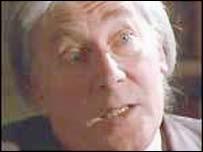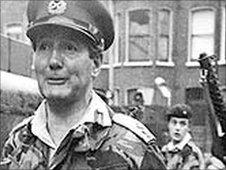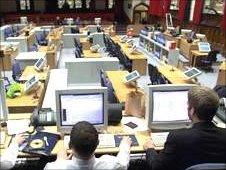Bloody Sunday: key soldiers involved
- Published
Although most of the Bloody Sunday Tribunal evidence was heard in Londonderry, the soldiers who were there on 30 January 1972 appeared in London amid security concerns.
Soldiers who were on the ground at the time of the shootings gave evidence anonymously. They were not granted immunity from prosecution; only immunity from self-incrimination.
The soldiers were cleared by a previous inquiry headed by Lord Widgery in 1972, but it was widely believed by relatives and campaigners to be a whitewash.
BBC News looks at what the report says about some of the army figures who appeared before the Saville Inquiry.
Colonel Derek Wilford

Derek Wilford was in charge of the Parachute Regiment on the day
On Bloody Sunday soldiers went into the Bogside as a result of an order from Colonel Derek Wilford, the officer in charge of the 1st Battalion of the Parachute Regiment.
Colonel Wilford never wavered from his conviction that his soldiers were fired on first and were merely doing their duty.
However, the Saville report has criticised his actions, saying he should not have launched the incursion into the Bogside.
It said he was wrong to do so because he disobeyed the orders given by his superior Brigidier McClellan, and also because his soldiers, whose job it was to arrest rioters, would have no or virtually no means of identifying them from those who had been involved in the march.
He was also wrong to send soldiers into an unfamiliar area where there was risk of attack from republican paramilitaries, in circumstances where the soldiers' response would risk people other than those engaging the soldiers with lethal force being killed or injured by army gunfire.
The report said Colonel Wilford either deliberately disobeyed Brigadier McClelland's order or failed for no good reason to appreciate the clear limits on what he had been authorised to do.
In 1972, Colonel Wilford was a 38-year-old lieutenant colonel, a well-respected high-flying officer.
He was exonerated by the Widgery tribunal and six months after the event he was awarded the Order of the British Empire by the Queen.
But he left the Army 10 years later and has since said he feels he was made a scapegoat for the events that took place on Bloody Sunday.
General Sir Robert Ford

General Sir Robert Ford failed to remember writing the memo
General Ford was the Commander of Land Forces in Northern Ireland in 1972, in effect number two in the army in NI.
He has been criticised in the Saville report for deploying soldiers to arrest rioters: "In our view his decision to use 1 Para as the arrest force is open to criticism but he did not know his decision would result in soldiers firing unjustifiably."
It said soldiers reacted by losing their self control and firing, forgetting or ignoring their instructions and training, and failing to satisfy themselves that they had identified targets posing a threat of causing death or serious injury.
The inquiry learnt of the existence of a memo, signed by Sir Robert, in which he suggested a policy of shooting some rioters in order to restore law and order in Derry.
In the secret memo to his superior, dated 7 January 1972, Sir Robert said he was "coming to the conclusion that the minimum force necessary to achieve a restoration of law and order is to shoot selected ringleaders amongst the DYH (Derry Young Hooligans), after clear warnings have been issued".
He describes the DYH as "gangs of tough teenage youths... who have developed sophisticated tactics of brick and stone throwing, destruction and arson."
In the general's mind the army was "virtually incapable" against these gangs, who operated under the cover of snipers and "undermined" the soldiers' ability to deal with gunmen and bombers.
But he did not advocate killing the ringleaders.
Sir Robert failed to remember writing the memo, while General Jackson told the inquiry: "People should be careful not to make a ridiculous jump from a memorandum like that to an allegation that there was a deliberate policy to shoot people."
Brigadier Pat MacLellan
The soldier in charge of the Army's operation on Bloody Sunday told the inquiry he may have chosen the wrong moment to send the Parachute Regiment into the Bogside.
Brigadier MacLellan said he was under the impression that there was enough separation between rioters and civil rights marchers to launch an arrest operation but that he may have given the order to go into the Bogside area at the wrong time.
He also told the tribunal that he did not know the details of the plan which was to be used by the paratroops going into the Bogside.
Brigadier MacLellan said he would not have knowingly supported the shooting of some rioters, and the idea of shooting a 15-year-old boy for throwing stones would not have helped the Army politically or militarily.
Soldiers E, F, G and H

Evidence from the soldiers was heard in London
These were the men at the heart of the shootings. On their own evidence they killed seven of the thirteen victims.
Soldier F agreed that he killed four people, but insisted he did not murder them.
The former paratrooper admitted killing Michael Kelly, Barney McGuigan and Paddy Doherty and an unidentified man in Glenfada Park.
When it was put to him in October 2003 that he murdered them without justification, he replied: "As I refer to my statements, the people I shot are the petrol bombers or a person who had a weapon."
But he was heavily criticised in the Saville Report for his actions.
It found when he shot Michael Kelly he not fire in panic or fear and he knew his victim was not a threat.
"We have no doubt that Lance Cpl F also shot Patrick Doherty and Bernard McGuigan," the report added.
The report also said that it was "more likely than not" that either soldier F or soldier H fired the shot that mortally wounded William McKinney.
It said either soldier G or soldier H fired a shot at Jim Wray when he was lying mortally wounded on the ground.
It said: "Whichever soldier was responsible for firing the second shot, we are sure he must have known that there was no possible justification for shooting Jim Wray as he lay on the ground."
Soldier H is recorded to have fired the most shots on Bloody Sunday.
Saville said there is "no doubt" that Soldier G was the officer who at a range of only a few yards fired at and mortally wounded Gerard McKinney in Abbey Park.
It said his shot passed through Gerard McKinney's body and also mortally wounded Gerald Donehhy.
It said Soldier G falsely denied that he had fired in Abbey Park.
Soldier G did not fire in fear or panic, according to the report.
It said: "We are sure that he must have fired knowing that Gerard McKinney was not posing a threat of causing death or serious injury."
Gerald Donaghy was found with four nail bombs in his pocket.
The report concluded that the nail bombs were probably on Gerald Donaghy when he was shot, but he was not preparing or attempting to throw a nail bomb at that time.
It said Mr Donaghy was not shot because of his possession of nail bombs, and that he was shot while trying to escape from the soldiers.
Soldier J
Soldier J told the inquiry he fired at two nail-bombers on Bloody Sunday.
The former paratrooper said he missed with a shot fired at a man who was about to throw a nail bomb at a barricade on Rossville Street.
He said he fired another shot at another man who was about to throw a smoking object from the corner of the Rossville Flats, but missed him as well.
Soldier J admitted he "hammed up" an account he gave to Daily Telegraph reporter Toby Harnden about things he did not actually see, in an attempt to secure anonymity for himself and his colleagues.
The former lance corporal apologised to the tribunal for denying that he was the source of the article, but said he did so because he feared for the safety of his family if his name leaked out.
Soldiers L and M
The report said that either Soldier L or M shot Kevin McElhinney as he was crawling south from the rubble barricade away from the soldiers.
Soldier P
Soldier P told the inquiry he did not remember killing two people and did not remember firing his rifle.
He said that he had to rely on evidence he gave to the Widgery Tribunal in 1972, held shortly after the shootings.
On further questioning, the soldier accepted that, in 1972, he said he had shot someone he believed to have been a nailbomber and a man with a pistol.
He had also said he fired two rounds at the alleged nail-bomber, four at the alleged gunman and also three rounds in the air.
Soldier P said it had been the only occasion in his Army career in which he fired live rounds, apart from at a shooting range.
"I don't see anyone from the Army and I don't go to reunions - I have just got on with my life and work. Accordingly, I recollect very little about the 30 January 1972," he told the Saville Inquiry.
Soldier R
The report said that Soldier R of mortar platoon was "probably" the soldier who aimed at and shot Jackie Duddy.
Soldier S
Soldier S said he believed he was justified in firing 12 shots at a man at the Rossville Flats who he said was shooting at him.
"Even the man that I identified as a gunman, who was obviously posing a threat to us in the alleyway, if I did hit him and kill him, it is still a tragedy, is it not?
He added: "This is a tragedy, it is a tragedy for everybody, I realise that and I am sorry that innocent people got killed on that day.
"I am very, very sorry for that, but for my action on the day, my particular action, I believe I was justified in what I did."
Soldier U
The report said that Soldier U of mortar platoon fired at and mortally wounded Hugh Gilmore as he was running south away from the soldiers.